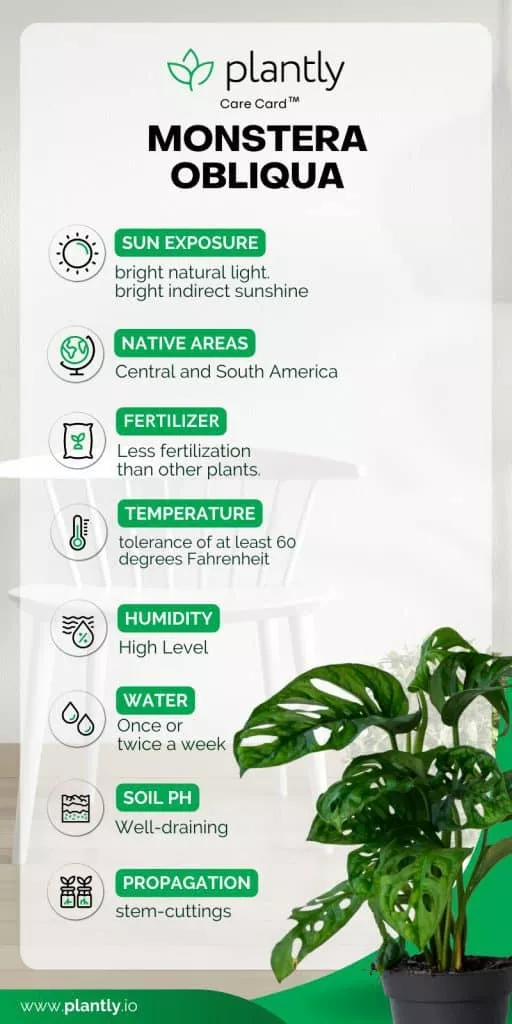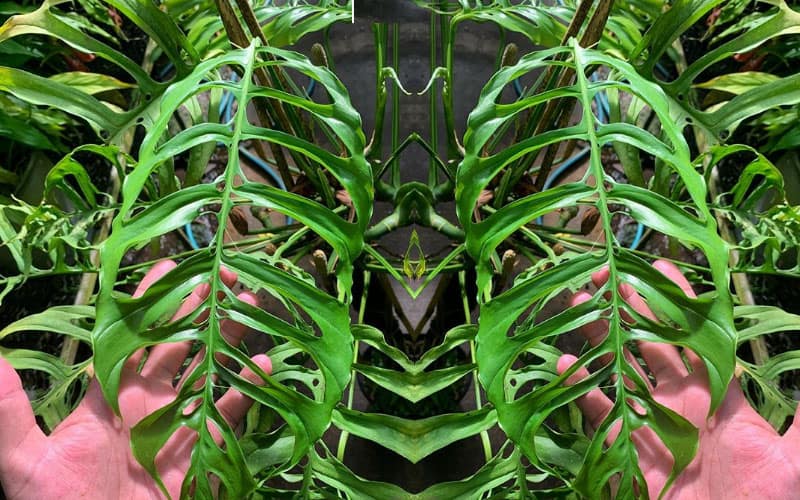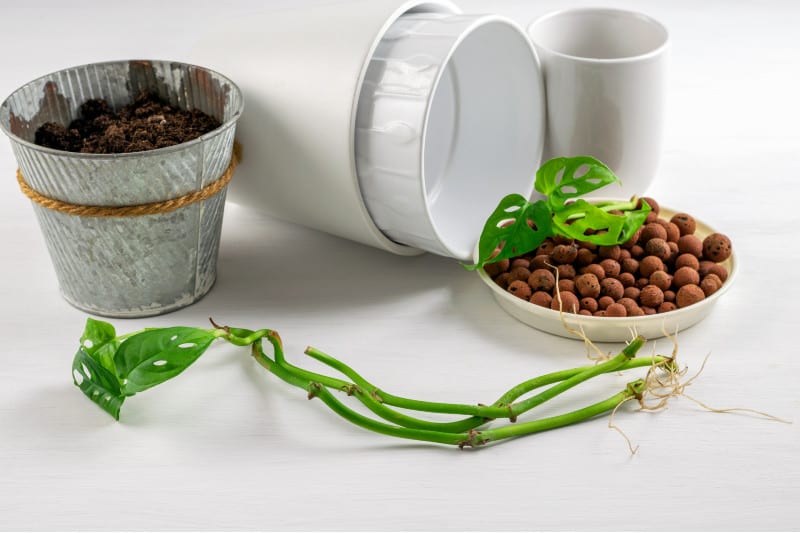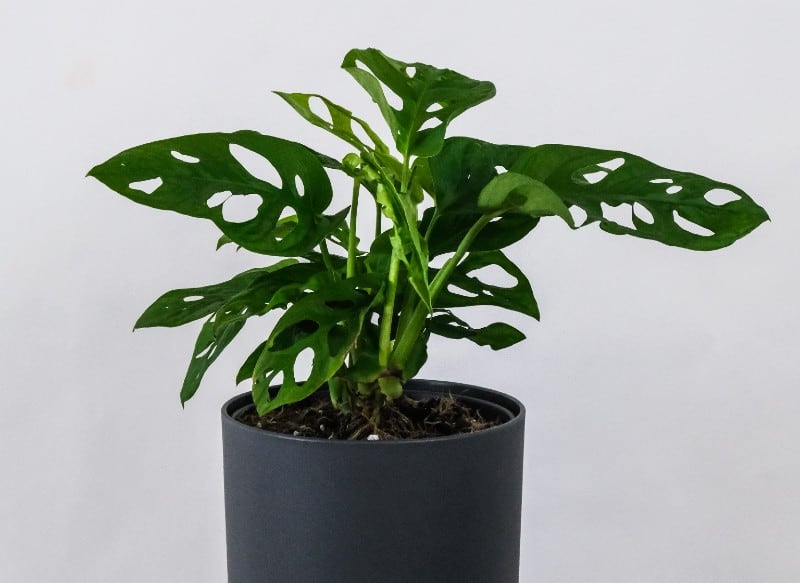No products in the cart.
Table of Contents
Are you dreaming of having Monstera Obliqua to add to your plant collection? First, understand how to take care of it. Every plant has its style of growing and being cared for, and we’ll be looking at Monstera Obliqua plant care in particular.
Be in love with Monstera Obliqua, which comes in a range of colors and shapes. Read more below to find out more!
Monstera Obliqua Introduction

The genus Monstera is made up of about 48 flowering plant species. The Latin word ‘Monstera,’ which means ‘abnormal,’ inspired these tropical American indigenous names. The name Monstera originated from the Latin word monstrum, which means uncommon or unusual.
It is a green climbing plant, quite similar to Monstera adansonii that grows to only a few meters in height. This refers to the bulk of the members’ characteristic pierced leaves.
These plants have aerial roots and are evergreen hemiepiphytes. Apart from assisting plants in climbing trees, these roots can also develop in soil. Monsteras are a common indoor plant. To assist you with growing one, we’ll show you a sample of what this Monstera Obliqua plant looks like.
Monstera Obliqua Plant Care Basics

Monstera Obliqua Plant is a delicate, rare plant perfect for those with a green thumb. From planting to blooming, having the appropriate knowledge on how to care for it goes a long way if you’re a plant enthusiast. Monstera Obliqua plant care now necessitates your special attention.
To begin, evaluate the soil, then water it, put it where the sunshine will not kill it, and lastly nurture it.
Let’s take a closer look at how Monstera Obliqua Plants are cared for in this article.
Best Potting Mix
Proper soil needs are an essential aspect of Monstera Obliqua Plant Care, and without the right growing mix, you won’t get the results you want. The soil should also be peat-based. Peat is advantageous because it stores water and allows the plant to absorb most of it.
Peat can be prepared from scratch or bought on the internet.
Other water-holding components can be found in the soil, such as coconut coir. Coir improves soil drainage while retaining moisture in quick-draining soils. Coir breaks down slowly, similar to peat, allowing excess moisture to drain away from plant roots.
A third factor in the soil should be loam. It will create tiny air holes, allowing the roots to spread out and obtain all nutrients. When growing Monstera Obliqua Seeds, they don’t utilize sand and dry soils or are purchased.
Watering Needs
Monstera Obliqua does not need to be watered frequently. It just has to be watered once or twice a week, especially during the summer, and once every two weeks during the winter. Only water it until the top of the soil dries off.
If the leaves of your Monstera Obliqua begin to turn brownish-yellow or get crippled, your plant is also suffering from dehydration. The darkening of leaves would be caused by waterlogging. Overwatering causes yellowed leaves, collapsed stems, and stunted development.
It’s also a good way to avoid watering your plant with cold water. Water requirements for Monstera Obliqua vary depending on location and zone.
Ideal Lighting

Monstera Obliqua enjoys bright natural light, and it will thrive in bright indirect sunshine. However, direct sun will burn the foliage and sear the fragile, thin leaves, so keep your plant out of direct sunlight. Because of its thick leaves, adult Monstera Obliqua can withstand at least 3 hours of direct sunlight.
Monstera Obliqua Plant Care is used to high humidity levels of up to 90%, as well as a deep jungle canopy to protect them from direct sunlight.
Temperature & Humidity
Monstera Obliqua is a tropical vine that requires a temperature tolerance of at least 60 degrees Fahrenheit. It can’t take a lot of heat. If you’re cultivating a gorgeous Monstera indoors, don’t allow the temperature to rise or decrease outside this range. As a result, the plant prefers temperatures between 16 and 20°C.
In greenhouses, where the temperature can be readily maintained, creating these circumstances is simple. If you can’t access a greenhouse, place the plant in a temperature-controlled room with a thermostat.
This is critically relevant in the winter; when the temperature drops below four degrees Celsius, the plant would die.
Which tropical plant doesn’t enjoy it when it’s hot and humid? Monstera Obliqua, like all other tropical plants, thrives in a humid environment. On a dry day, misting it frequently and putting it in a vivarium with other plants will have a long way toward keeping the humidity levels around it.
If your home isn’t particularly humid, keep the plant near the bathroom or in the kitchen. Regularly check the soil moisture, examine the leaves, and mist the plant if the air appears to be too dry. Another option is to place your Monstera Obliqua in a room that has a humidifier.
Monstera Obliqua plant care needs a high level of humidity.
Fertilizer
Fertilizers are required for all plantings; however because Monstera Obliqua is a slow-growing plant, it requires less fertilization than other plants. During the growing weeks, however, feed your Monstera with a houseplant-labeled feed every two weeks.
Fertilize it once a month using a mild fertilizer in small amounts during the spring and summer months. In the winter, however, it is advisable to let the plant rest to avoid any salt buildup in the soil, injuring the plant’s foliage and causing it to burn.
Monstera Obliqua grows slowly, and if you don’t fertilize it, it will grow even slower.
Propagation
Monstera Obliqua plant care needs propagation, and stem cuttings can propagate these stunning plants. The propagating medium can be either soil or water. Always take the cuttings during the growing seasons, from spring to the start of summer.

When you cut the plant, make sure it has a leaf and nod. Place the cutting in a pot, use peat and loam compost and generously water the top layer.
In a few weeks, the roots will develop properly, and the plant will slowly start growing. With all these propagation methods, the idea is to encourage further roots to form, then pot this Monstera into fresh compost.
Growth Zone
The geographical range extends from Panama to South America. Costa Rica, Peru, and the Amazon River all have it. Isn’t it amazing that this plant has only been observed a few times, given its extensive geographical location? Because it is one of the smallest Monstera species, it is frequently overlooked.
Monstera Obliqua is a small, slow-growing plant that would take 12-18 months for you to see new leaves. Patience is required if you want to see its maturity, so trimming its vine when it’s rangy will give plenty of room for new growth.
Misting your Monstera Obliqua regularly is also a good idea when you want to give them small treats.
Potting

When you receive your plant and set it in the container, make sure the soil surface is damp. Because this is a slow-growing plant, it will not need to be re-pot for the first three weeks after planting. Because these are climbers, they can be potted in a conventional pot with the addition of a totem or moss for more support.
These, on the other hand, can be planted in a hanging basket and would look stunning dangling from a hung basket.
Pruning your plant is best done at the start of the growing season, usually in the spring. To allow other vines to develop, remove the leggy growth and dead foliage. Move your lovely plant to a new, larger container if part of its roots are poking out of drainage holes, or re-pot them when the need arises.
Monstera Obliqua Varieties and Similar Plants
Monstera species can blossom, which is why they are classified as Araceae. Monstera is a genus with 45 species, including the Monstera Deliciosa and Monstera Adansonii.
Each of Monstera’s 45 species has distinct characteristics that serve to recognize it from the rest. There are a few traits that all Obliqua Monsteras have in common, such as leaf size and form and total plant size. Monstera vines are distinguished by their huge, dark green, glossy leaves.
Monstera Obliqua Diseases & Pests
Check the leaves, stems, and soil for insects, webbing, insect damage, or clear sticky sap that indicates the presence of insects before purchasing a Monstera Obliqua plant.
If you notice anything, choose a new plant or retailer, and if you buy another Monstera Obliqua, keep it apart from your other houseplants for a few days or even weeks to avoid pests from spreading. This will also allow any eggs to hatch, allowing you to address the situation and remove the insects from your Monstera before applying.
A Monstera Obliqua plant’s life can be cut short due to disease. It is a delicate plant susceptible to root rot, mosaic virus, molds, and leaf scorch. Spider mites can eat the exotic leaves of your lovely plant, causing it to die. To prevent diseases or pests from spreading among surrounding plants, it is preferable to chop off the affected areas.
Frequently Asked Questions
Monstera obliqua has bigger and wider leaves than Monstera adansonii.
Obliqua grows slowly and the supply is short compared to the Adansonii. It has been sought by collectors and enthusiast alike that makes it even more rare. FYI: propagationg the Obliqua is difficult compared to their other specie due to their special propagation requirement.
Yes since most of the monsteras are a vining plants too.
In it’s natural habitat, this plant can grow up to 6-10 feet tall depending how long the plant lived and how tall the tree they’re climbing into.
If you treat this as an indoor plant with a moss pole that it can climb to, it can really outgrow its pole if the environment of the plant is quite similar to it’s native habitat. It would also depend on how many years you have that plant. With bright, indirect light situation, well-draining mix and necessary watering, expect your obliqua can grow as long as you allow them to.
However, monstera obliqua is a rare and slow growing plant, don’t expect to see tremendous growth on them.
Unlike Monstera Adansonii which is a fast-growing plant, Monstera obliqua is unfortunately a slow-growing plant. Aside from being rare, this plant takes around 12-18 months before you’ll see a new leaf growing.
Whether you want to buy, sell or simply reach out to other plant enthusiasts, Plantly is the right place to be!


